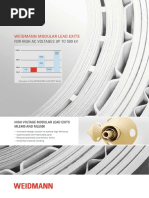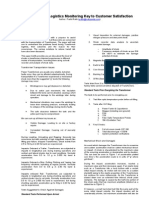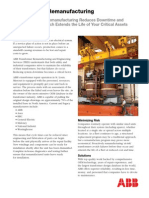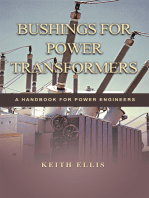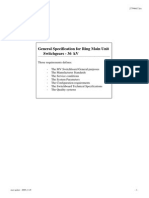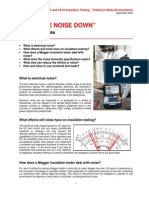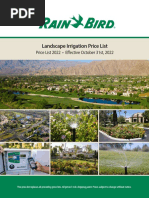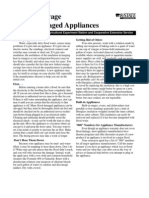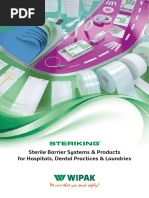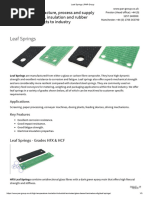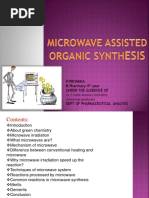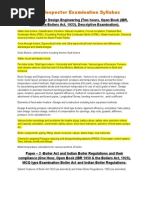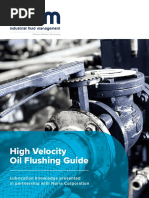Estimating Moisture in Power Transformers: Mohammad Tariq, Megger
Estimating Moisture in Power Transformers: Mohammad Tariq, Megger
Uploaded by
poeta_oscuroCopyright:
Available Formats
Estimating Moisture in Power Transformers: Mohammad Tariq, Megger
Estimating Moisture in Power Transformers: Mohammad Tariq, Megger
Uploaded by
poeta_oscuroOriginal Title
Copyright
Available Formats
Share this document
Did you find this document useful?
Is this content inappropriate?
Copyright:
Available Formats
Estimating Moisture in Power Transformers: Mohammad Tariq, Megger
Estimating Moisture in Power Transformers: Mohammad Tariq, Megger
Uploaded by
poeta_oscuroCopyright:
Available Formats
Estimating moisture in Power Transformers
S7
1
Mohammad Tariq, Megger
Mohammad Tariq was born 1983 and graduated from University Of
Bahrain with distinction on 2005 and joined Megger in early 2006. Currently
he is a senior applications engineer with Megger in the eld of advanced
electrical protection, cable fault location and diagnostics and transformer
diagnostics. He was involved in development of relay protection testing
software modules and authored several papers , technical notes and appli-
cation guides.
S7
2
*) Megger Sweden AB, Box 724, 182 17 Sweden email: matz.ohlen@megger.com
Moisture in Power Transformers
- How to Estimate and What to Do
Matz Ohlen, Megger Sweden
Abstract Modern technology and developments in signal
acquisition and analysis techniques have provided new tools for
transformer diagnostics. Of particular interest are dielectric
response measurements where insulation properties of oil-paper
systems can be investigated. Dielectric Frequency Response, DFR
(also known as Frequency Domain Spectroscopy, FDS), was
introduced more than 15 years ago and has been thoroughly
evaluated in a number of research projects and field tests with
good results. DFR data in combination with mathematical
modeling of the oil-paper insulation is proven as an excellent tool
for moisture assessment. The dryness of the oil-paper insulation
systems in power transformers is a key factor in both their short
and long term reliability since moisture has deleterious effects on
dielectric integrity and insulation ageing rates. This paper gives a
background to moisture issues in transformers, where it comes
from, how it can be measured, how it can be addressed and how
this can be used for decisions on maintenance and/or replacement.
Keywords moisture, power transformers, dielectric frequency
response; DFR; frequency domain spectroscopy; FDS; power factor;
dissipation factor
I. INTRODUCTION
With an aging power component population, todays
electrical utility industry faces a tough challenge as failures and
consequent repair and revenue loss may inflict major costs.
Transformers have become one of the most mission critical
components in the electrical grid. The need for reliable
diagnostic methods drives the worlds leading experts to
evaluate new technologies that improve reliability and optimize
the use of the power network.
The condition of the insulation is an essential aspect for the
operational reliability of electrical power transformers,
generators, cables and other high voltage equipment.
Transformers with high moisture content have a higher aging
rate and can not without risk sustain higher loads.
On the other hand it is also very important to identify
good units in the aging population of equipment. Adding just
a few operating years to the expected end-of-life for a
transformer means substantial cost savings for the power
company.
II. MOISTURE IN TRANSFORMERS
The insulation system of power transformers consists of oil
and cellulose. Both materials generally change their dielectric
properties during the life of the transformer and among factors
contributing mostly to the degradation of transformer insulation
moisture plays an important role. Presence of water in solid
part of the insulation, even in small concentrations, increases
its aging rate, lowers the admissible hot spot temperature and
increases the risk of bubble formation. In addition, moisture
reduces the dielectric strength of transformer oil as well as the
inception level of partial discharge activity [1].
A. Where is the water?
When discussing moisture in transformers it is important to
understand where the water resides. Consider the following
example (typical values for a 300 MVA service aged power
transformer at 50C):
The insulation in a power transformer consists of oil
impregnated cellulose and oil.
60 tons of oil with water content of 20 ppm = 1.2 liter
10 tons of cellulose with 3% water content = 300 liter
Almost all water is in the cellulose!
During normal operation at different loads and temperatures
the water moves back and forth between oil and cellulose.
Sometimes the water content in the oil is doubled, 40 ppm/2.4
liter. However the moisture in the cellulose remains almost the
same, 299 liter. The average moisture content in the solid
insulation is very constant!
B. Moisture accelerates aging
Aging of the cellulose insulation is directly related to the
moisture content. Figure 1 describes life expectancy for the
insulation at various temperatures and moisture content [3]. At
90C, cellulose with 1% moisture has a life expectancy of
about 12 years. At 3% moisture the life expectancy is only 3
years!
Estimating moisture in Power Transformers
Estimating moisture in Power Transformers
S7
3
Figure 1. Life expectancy for cellulose at different temperature and moisture
content [3]
C. Moisture limits the loading capability
A rise in temperature, especially at thick insulation layers,
causes evaporation of adsorbed water with a high vapor and
gas pressure within the inner layers of paper. This pressure may
become high enough to create formation of vapor-filled cavities
(bubbles) on the insulation surface with subsequent decrease of
the dielectric strength [2].
Figure 2 describes limitation of load conditions due to
moisture content [4].
Figure 2. Recommended maximum loading limits (IEEE) as function of
moisture [4]
D. Where does the water come from?
Transformers are dried during the manufacturing process
until measurements or standard practices would yield a
moisture content in the cellulosic insulation of less than 0.5%
to 1.0% depending upon purchasers and manufacturers
requirements. After the initial drying, the moisture content of
the insulation system will continually increase. There are three
sources of excessive water in transformer insulation [2]:
Residual moisture in the thick structural components not
removed during the factory dry-out or moistening of the
insulation surface during assembly
Ingress from the atmosphere (breathing during load cycles,
site erection and/or maintenance/repair processes)
Aging (decomposition) of cellulose and oil.
1) Residual moisture
Excessive residual moisture can remain in some bulky
insulating components, particularly in wood and plastic or
resin-impregnated materials, which need much longer drying
times in comparison to paper and pressboard. Typically, these
are supports for leads, support structures in the load tap
changer (LTC), support insulation for the neutral coils of the
winding, cylinders, core support insulation, etc.
Different insulation materials require different drying
durations. The drying time is roughly inversely proportional to
insulation thickness in square. However the structure of
material is an important factor as well, e.g. pressboard featuring
a high density requires longer drying time than low density
pressboard. [2].
New transformers are generally dried to a moisture content
< 1%. When drying larger transformers, the residual moisture
may be as low as about 0.3%.
2) Ingress from the atmosphere
The main source of the buildup of water in transformers is
the atmosphere and there are several mechanisms and
occasions for moisture ingress.
Exposure to humid air during site installation
Leaking gaskets and faulty water traps may expose the
inside of the transformer to moisture humid air
Exposure to humid air during maintenance
3) Decomposition of cellulose
The aging of cellulosic materials leads to molecular chain
scission and the formation of byproducts including water and
furanic compounds.
Figure 3 describes several studies on how moisture is
produced as a function of number of chain scissions. After five
chain scissions a paper starting at a degree of polymerization of
1200 has ended up with a DP of 200 [2] (curves should only be
considered as indicators on the order of magnitude of the water
producing effect).
Typical increase of moisture in a transformer can be in the
order of 0.05 0.2%/year pending design [2, 5]
Estimating moisture in Power Transformers
Estimating moisture in Power Transformers
S7
4
Figure 3. Produced water as a function of number of chain scissions [2]
III. STANDARDS AND RECOMMENDATIONS FOR MOISTURE
International standards and guides give some
recommendations for moisture assessment. As an example
IEEE C57.106-2002 recommended the following approximate
percent by weight of water in solid insulation.
< 69 kV, 3% maximum
> 69 - < 230 kV, 2% maximum
230 kV and greater 1.25% maximum
Other standards and guides only give a classification of the
moisture content. Figure 4 depicts moisture categories
according to some standards and practices.
Figure 4. Moisture assessment examples
IV. MOISTURE MEASUREMENTS
There are several methods available to measure the
moisture content in the solid insulation of the transformer.
Direct method
Take paper sample from transformer and measure moisture
content using Karl Fisher titration
Indirect methods
Moisture in oil
o Absolute values
o Relative saturation
Power frequency tan delta/power factor measurements
Dielectric response measurements
o Return Voltage Measurement (RVM) DC
method
o Polarization-Depolarization Current
measurements (PDC) DC method
o Dielectric Frequency Response measurements
(DFR/FDS) AC method
A. Direct method KFT on paper samples
Karl Fischer titration allows for determining trace amounts
of water in a sample using volumetric or coulometric titration.
Its principle is to add a reagent (titre iodine) to a solution
containing an unknown mass of water until all water reacts
with the reagent. From the amount of reagent the mass of water
can be calculated.
Several factors may affect the results of KFT analyses, e.g.:
There is always ingress of moisture from the atmosphere
during sampling, transportation and sample preparation.
This happens particularly during paper sampling from
open transformers
Cellulose binds water with chemical bonds of different
strengths. It is uncertain whether the thermal energy
supplied releases all the water.
Heating temperature and time certainly changes the
released water.
To investigate the effect of these influences and to evaluate
the discrepancies that may result from KFT analyses, a round
robin test (RRT) was carried out among seven laboratories
from four European countries [1]. It concentrated on analyzing
the water content in paper relative to weight and the water
content in oil relative to weight in three oil and paper samples
according to the respective laboratorys standard procedures.
The obtained results revealed an unsatisfactory comparability
between the laboratories, as shown below in Figure 5.
As seen in the figure the results show large variations. For
sample A, containing little water, the comparability was worst.
Moisture estimates varied between 1.0% and 2.0%.
Another issue for direct measurements of moisture in
cellulose is the uneven distribution of moisture. In the
REDIATOOL project [8], samples were taken from different
parts of a transformer and analyzed for moisture. Results are
presented in Figure 6. As seen in the figure the moisture
distribution is very uneven between different parts and
locations. To get a true result from KFT analysis of paper it
is important to take many samples and average the results.
Estimating moisture in Power Transformers
Estimating moisture in Power Transformers
S7
5
Figure 5. Moisture content in paper in % relative to weight as measured by
seven laboratories [1].
Figure 6. Moisture content estimated by means of KFT in samples of
transformer solid insulation at different locations and sampling events [8]
Water content determination by means of dielectric
response or other indirect methods is often calibrated by
comparing them with evaluations based on KFT. However, as
shown above, KFT results also suffer from a poor
comparability between different laboratories. The user must
therefore be aware of this fact, and understand that a deviation
in the comparison does not necessarily point out weaknesses of
the evaluated methods.
B. Moisture in oil
Measuring moisture levels in oil is probably the most
common method for moisture assessment. Many operators of
power transformers apply equilibrium diagrams to derive the
moisture by weight (%) in cellulose from the moisture by
weight in oil (ppm). This approach consists of three steps:
1. Sampling of oil under service conditions
2. Measurement of water content by Karl Fischer Titration
3. Deriving moisture content in paper via equilibrium charts .
The procedure is affected by substantial errors, e.g:
Sampling, transportation to laboratory and moisture
measurement via KFT causes unpredictable errors.
Equilibrium diagrams are only valid under equilibrium
conditions (depending on temperature established after
days/months).
A steep gradient in the low moisture region (dry
insulations or low temperatures) complicates reading.
The user obtains scattered results using different
equilibrium charts.
Equilibrium depends on moisture adsorption capacity of
solid insulation and oil.
The influence of sampling, transportation and laboratory
analysis has been evaluated in a round robin test carried out
among seven laboratories [1]. The obtained results also here
revealed an unsatisfactory comparability between the
laboratories, as shown below in Figure 7.
Figure 7. Moisture content in oil in ppm relative to weight as measuredby the
laboratories [1]
For the drier samples A and B only a trend was
recognizable; the results varied from 3.5 to 12.1 ppm for
sample A and from 5.8 to 19.8 ppm for sample B. Systematic
differences were obvious. It has to be mentioned that for the
dry oils, the results also varied within one single laboratory and
a standard deviation of 20% is not unusual.
The amount of water in the oil is used to derive moisture
content in paper by using equilibrium charts. Several charts are
available, below figure 8 shows Oomen. Note the steep
gradient the low moisture region that severely complicates
reading.
Estimating moisture in Power Transformers
Estimating moisture in Power Transformers
S7
6
Figure 8. Equilibrium chart for moisture content in paper versus water content
in oil at various temperatures.
One step to improve the method of using equilibrium
diagrams is to use the relative saturation in oil (%) or water
activity instead of the moisture by weight (ppm). In case direct
measurements are performed with a probe mounted directly on
the transformer this method removes the issues with sampling
and transportation. Furthermore the moisture absorption
capacity is less temperature dependent and oil aging and its
influence on moisture saturation level becomes negligible,
since it is already included into relative saturation [2]. However
the method is still pending equilibrium and charts are pending
material.
C. Power frequency tan delta/power factor measurements
Tan delta/Power factor measured at power frequency (50/60
Hz) shows the combined dissipation factor coming from losses
in oil and cellulose. It is known that the measurement cannot
discriminate a dry transformer with service aged oil from a wet
transformer with new oil and the method is relatively
insensitive to moisture levels < 2%.
Figure 9 describes the relation between power frequency
tan delta values and moisture levels for a new and service-aged
typical core-form transformer. At 0.3% power factor (20C),
the moisture may be from 0.5% to about 2% pending the
condition of the oil.
Figure 9. Tan delta (% @ 20C) vs moisture (%) for a new and service-aged
typical core-form transformer
Furthermore it is also well-known that the standard tan
delta temperature correction factors/tables (TCF) given in
standards and many instrument manufacturers user
manuals/recommendations, are incorrect for the individual
transformer [9]. This adds an additional source of inaccuracy to
the method.
D. Dielectric response measurements
Dielectric response measurements can be performed in time
(DC) or frequency (AC) domain. The most common
measurement techniques/methods are:
DC methods Time domain
Return Voltage Measurement (RVM); Voltage vs time
Polarization-Depolarization Current Measurement (PDC);
Current vs time
AC method Frequency domain
Dielectric Frequency Response Measurements
(DFR/FDS); Capacitance and dissipation factor vs
frequency
The different methods have been thoroughly investigated in
several tests and experiments [7]. The dielectric response
methods RVM, PDC and DFR/FDS where used to analyze the
moisture content for different arrangements of insulation
geometry at different temperatures by the corresponding
software programs. Results were compared to KFT analysis.
The results of RVM analysis differed strongly, although the
moisture content of paper was constant during all the
measurements. Dependences on the oil conductivity as well as
on the temperature and the insulation geometry appeared.
Hence the RVM software used could not evaluate moisture in
oil-paper-insulation systems well since the interpretation
scheme used was inaccurate without taking into account the
geometry and oil parameters.
Results of PDC analysis showed much smaller influence of
insulation geometry and weaker temperature dependence.
These influences were already compensated by the
interpretation software used. With increasing oil conductivity
the evaluated moisture content increased, although in reality it
remained constant. Nevertheless, the simulation results were
close to the level evaluated by Karl Fischer titration.
The DFR/FDS analysis provided the best compensation for
insulation geometry. At the same time, the paper seemed to
become drier with increasing temperature. This actually
happens in reality because of moisture diffusing out of the
paper, but not to indicated extent. The observed tendency rather
reveals imperfect compensation for temperature variations.
Similarly as for the other methods, an increased oil
conductivity results in a slight increased of the estimated
moisture content. For more details please see [7]
1) Dielectric Frequency Response Measurements
The first field instrument for DFR/FDS measurements of
transformers, bushings and cables was introduced 1995 [9].
Since then numerous evaluation of the technology has been
performed and as an example, several international
projects/reports define dielectric response measurements
together with insulation modeling as the preferred method for
Estimating moisture in Power Transformers
Estimating moisture in Power Transformers
S7
7
measuring moisture content of the cellulose insulation in power
transformers [1], [6], [7].
In DFR tests, capacitance and dissipation/power factor is
measured. The measurement principle and setup is very similar
to traditional 50/60 Hz testing with the difference that a lower
measurement voltage is used (200 Vpeak) and instead of
measuring at line frequency 50/60 Hz, insulation properties are
measured over a frequency range, typically from 1 kHz down
to 1 mHz.
The results are presented as capacitance and tan
delta/power factor versus frequency. Measurement setup is
shown in Fig 10 and typical DFR results from measurement on
transformers in different conditions in Fig 11.
Figure 10. DFR/FDS test setup
Figure 11. DFR measurements on four different transformers at different
temperatures with moisture content ranging from 0.3% to 3.4%
a) Moisture Assessment
The method of using DFR for determining moisture content
in the oil-paper insulation inside an oil-immersed power
transformer has been described in detail in several papers and
articles elsewhere [1], [6], [7], [10] and is only briefly
summarized in this paper.
The dissipation factor for an oil/cellulose insulation plotted
against frequency shows a typical inverted S-shaped curve.
With increasing temperature the curve shifts towards higher
frequencies. Moisture influences mainly the low and the high
frequency areas. The middle section of the curve with the steep
gradient reflects oil conductivity. Fig 12 describes parameter
influence on the reference curve.
Figure 12. Parameters that effects the dissipation factor at various frequencies
Using DFR for moisture determination is based on a
comparison of the transformers dielectric response to a
modeled dielectric response (reference curve). A matching
algorithm synthesizes a modeled dielectric response and
delivers a reference curve that reflects the measured
transformer. Results are displayed as moisture content along
with the temperature corrected power frequency tan delta and
oil conductivity. Only the insulation temperature (top oil
temperature and/or winding temperature) needs to be entered as
a fixed parameter. Figure 13 depicts results after insulation
analysis/assessment.
Figure 13. DFR insulation analysis/assessment
2) Comparing DC and AC techniques/methods
DC and AC measurements can be performed at low or high
voltage and it is also possible to combine techniques by
mathematically convert time domain data to frequency domain
data and vice versa [11]. When selecting a suitable method for
field measurements it is important to consider how sensitive the
instrument is to substation interference.
A summary is presented in Table I. AC methods are
generally more robust in high-interference conditions. DC
methods and in particular low voltage DC measurements are
very sensitive to DC interference from e.g. corona. The
Estimating moisture in Power Transformers
Estimating moisture in Power Transformers
S7
8
interference will add to the measured polarization current
which the analysis SW will interpret as increased moisture in
the insulation.
TABLE I. NOISE SENSITIVITY FOR DIFFERENT DIELECTRIC RESPONSE
MEASUREMENT METHODS
Interference
signals
DFR Measurement Technologies
Low
Voltage DC
Low
Voltage AC
High
Voltage AC
AC
(50/60Hz +
harmonics)
Sensitive
Not
sensitive
Not
sensitive
DC/VLF
Very
sensitive
Sensitive
Not
sensitive
V. TRANSFORMER DRYING
Transformer drying is an important maintenance action in
todays aging transformer fleet and several reports and
publications describe the issues related to drying [11], [12],
[13] (it is not the intention of this paper to cover details on the
different processes, the interested reader is recommended to
study the references).
The different methods for drying can be summarized as
follows:
Two major techniques are used:
Drying the insulation by drying the oil Field
Drying the insulation with heat and vacuum Field and
factory
Drying the oil can be performed with:
Molecular sieves
Cellulose filters
Cold traps
Combined oil regeneration and degassing
Drying the insulation can be performed with:
Vacuum and heat
Pulsation drying through oil circulation
Hot oil spray drying
Low frequency heating
Vapour phase drying
All methods can remove water out of the transformer
insulation. However the efficiencies in the different techniques
vary to a very large extent. See Figures 14 and 15 describing
water extraction capacity and the time needed for drying a 400
MVA transformer with 14 ton insulation from 3% down to
1.5% moisture.
Figure 14. Drying velocity from 3% down to 1,5 % average humidity
Figure 15. Drying time to dry a 400 MVA transformer with 14 ton insulation
from 3% down to 1,5 % average humidity [13]
VI. FIELD EXPERINCES
A. Maintenance based on water in oil analysis
TABLE II. MOISTURE IN SOLID INSULATION BASED ON WATER IN OIL
ANALYSIS COMPARED TO DFR ANALYSIS
Transformer Type
% moisture
in insulation
(from oil
analysis)
% moisture
in insulation
(from DFR)
Oil
Cond
(pS/m)
1 Core 2.5 0.9 0.38
2 Core 1.8 0.9 0.49
3 Core 1.4 0.9 0.41
4 Core 2.8 0.7 1.3
5 Shell Not available 1.2 1.5
6 Core 3.5 2 3.0
7 Shell 3.3 1 0.30
Estimating moisture in Power Transformers
Estimating moisture in Power Transformers
S7
9
A utility had selected seven transformers for oil
regeneration and drying. The decision was based on water in
oil measurements. Before processing the service company
suggested DFR measurements to verify status before treatment
[14].
Tables II show results from oil tests and DFR
measurements. Out of the seven transformers selected only 1 or
2 needed treatment! This is an example of how water in oil
analysis tend to overestimate moisture in solid insulation
B. On-line oil regeneration and drying
In this example a 30+ year distribution transformer was
selected for oil regeneration and drying. Transformer and
process information:
25 MVA manufactured 1972
17 days of hot oil circulation with clay filtering (Fullers
earth)
PF down from 0.4% to 0.3%
Moisture in cellulose not significantly reduced. 3% before
drying and 2.7% after drying
Degraded oil significantly improved. Conductivity before
regeneration 12.0 pS/m and 1.6 pS/m after filtering
DFR measurements before-after treatment is presented in
Figure 16.
Figure 16. DFR measurements before-after oil regeneration and drying of a 25
MVA transformer [15]
VII. SUMMARY AND CONCLUSIONS
Moisture is one of the the worst enemies of the
transformer!
o Limits the loading capability
o Accelerates the aging process
o Decreases dielectric strength
The water/moisture in a transformer resides in the solid
insulation, not in the oil
Dielectric Frequency Response Measurement is a great
technique for moisture assessment as it can measure:
o Moisture content in the cellulose insulation
o Conductivity/dissipation factor of the insulating
oil accurately corrected to 25C reference
temperature
o Power frequency tan delta/power factor,
accurately temperature corrected to 20C
reference temperature
Drying a power transformer can take from days to years
pending drying process and technology
VIII. REFERENCES
[1] CIGRE Technical Brochure 414, Dielectric Response Diagnoses For
Transformer Windings, 2010
[2] CIGRE Technical Brochure 349, Moisture Equilibrium and Moisture
Migration Within Transformer Insulation Systems, 2008
[3] Lars E. Lundgaard, Walter Hansen, Dag Jinhjell, and Terence J. Painter,
`Aging of Oil-Impregnated Paper in Power Transformers, IEEE Trans.
On Power delivery, Vol. 19, No. 1, January 2004, pp. 230-239
[4] G. K. Frimpong et al, Estimation of Moisture in Cellulose and Oil
Quality of Transformer Insulation using Dielectric Response
Measurements, Doble Client Conference, 2001.
[5] S.M. Gubanski et al, "Dielectric Response Methods for Diagnostics of
Power Transformers, Electra, No. 202, June 2002, pp 23-34also in
CIGRE Technical Brochure, No. 254, Paris 2004
[6] S.M. Gubanski et al, Reliable Diagnostics of HV Transformer
Insulation for Safety Assurance of Power Transmission System.
REDIATOOL - a European Research Project, paper D1-207 CIGRE
2006
[7] IEEE C57.12.90-2006, IEEE Standard Test Code for Liquid-Immersed
Distribution, Power, and Regulating Transformers
[8] P. Werelius et al, Diagnosis of Medium Voltage XLPE Cables by High
Voltage Dielectric Spectroscopy, paper presented at ICSD 1998.
[9] U. Gfvert et al, Dielectric Spectroscopy in Time and Frequency
Domain Applied to Diagnostics of Power Transformers, 6th
International Conference on Properties and Applications of Dielectric
Materials, June 21-26, 2000, Xi'an, China.
[10] Mats Karlstrom et al, Dielectric Response Measurements in Frequency,
Temperature and Time Domain, TechCon AsiaPacific 2013
[11] Andreas Gruber, Online Treatment of Transformers and Regeneration
of Insulating Oil, TechCon AsiaPacific 2009
[12] Georg Daemisch, On line drying as indispensable part of Life time
strength conservation of power transformers, On-line drying panel
session, Regensburg seminar
[13] Paul Kostiner et al, Practical Experience With the Drying of Power
Transformers in the Field Applying the LFH Technology, CIGRE 2004,
A2-205
[14] ABB Advanced Diagnostic Testing Services Provide Detailed Results,
2006
[15] Poorvi Patel, B. Holmgren,DFR - A Powerful Tool for Transformer
Diagnostics, TechCon AsiaPacific 2009
Estimating moisture in Power Transformers
You might also like
- The Technology of Instrument Transformers: Current and Voltage Measurement and Insulation SystemsFrom EverandThe Technology of Instrument Transformers: Current and Voltage Measurement and Insulation SystemsNo ratings yet
- Auto-Transformer Design - A Practical Handbook for Manufacturers, Contractors and WiremenFrom EverandAuto-Transformer Design - A Practical Handbook for Manufacturers, Contractors and WiremenRating: 4 out of 5 stars4/5 (2)
- The Standard Penetration Test - Its Application and Interpretation - Stroud-1989Document21 pagesThe Standard Penetration Test - Its Application and Interpretation - Stroud-1989Rajeev Kusugal67% (3)
- Potassium Carbonate Using AspenplusDocument5 pagesPotassium Carbonate Using AspenpluspancokomNo ratings yet
- Dielectric Response Analysis JDerecho PRESMATDocument20 pagesDielectric Response Analysis JDerecho PRESMATjaime100% (1)
- Developments in Insulating Paper For Pow PDFDocument30 pagesDevelopments in Insulating Paper For Pow PDFDante FilhoNo ratings yet
- Review On Effects and Causes of Insulation Paper Moisture On TransformerDocument4 pagesReview On Effects and Causes of Insulation Paper Moisture On TransformerRushikesh KulkarniNo ratings yet
- Paper - A Measurement Technique To Identify and Locate Partial Discharge in Transformer With AE and HFCTDocument6 pagesPaper - A Measurement Technique To Identify and Locate Partial Discharge in Transformer With AE and HFCTNguyen Vu Nhat HaNo ratings yet
- S2-4-SC Withstand Test of - EHV - Transformer - Learnings - Challenges-C Jayasenan-Siemens - Rev1Document8 pagesS2-4-SC Withstand Test of - EHV - Transformer - Learnings - Challenges-C Jayasenan-Siemens - Rev1MallikarjunNo ratings yet
- Trformer RegulationDocument4 pagesTrformer RegulationKrishnanNo ratings yet
- Influence of Humidity On The Breakdown Voltage of D-C. and A.C. Voltages in AirDocument5 pagesInfluence of Humidity On The Breakdown Voltage of D-C. and A.C. Voltages in AircisnatelNo ratings yet
- Moisture Equlilibrium and Moisture Migration-CIGRE BROCHURE 349 PDFDocument6 pagesMoisture Equlilibrium and Moisture Migration-CIGRE BROCHURE 349 PDFalex696No ratings yet
- Understanding Water in Transformer SystemsDocument4 pagesUnderstanding Water in Transformer SystemssulemankhalidNo ratings yet
- Modular Lead Exit - Info SheetDocument2 pagesModular Lead Exit - Info SheetSunil GurubaxaniNo ratings yet
- Transformer Life Extension Pdmsa Southafrica 2010Document17 pagesTransformer Life Extension Pdmsa Southafrica 2010Eddy Fernando Queca CadizNo ratings yet
- CoreTec 4 - Transformer Monitoring PlatformDocument2 pagesCoreTec 4 - Transformer Monitoring PlatformJaime Vicuña CubillosNo ratings yet
- Trafo DFRDocument22 pagesTrafo DFRchirag100% (1)
- Insulation Oil FilledDocument8 pagesInsulation Oil FilledxandreayNo ratings yet
- Transformer Logistics Monitoring Key To Customer SatisfactionDocument6 pagesTransformer Logistics Monitoring Key To Customer SatisfactionMasplantiz Technologies Private Ltd.No ratings yet
- Iec 60099-4 - 2009Document30 pagesIec 60099-4 - 2009Wellington MendonçaNo ratings yet
- Thermal SimulationDocument40 pagesThermal SimulationAbdul HadiNo ratings yet
- Assessing Degradation of Power Transformer Solid Insulation Considering Thermal Stress and Moisture VariationDocument12 pagesAssessing Degradation of Power Transformer Solid Insulation Considering Thermal Stress and Moisture VariationNajiyah SalehNo ratings yet
- Negative Dissipation Factor: IssueDocument4 pagesNegative Dissipation Factor: IssueBalu MNo ratings yet
- Vol 11 Issue 3Document124 pagesVol 11 Issue 3VerdierNo ratings yet
- S1 3 P 1Document5 pagesS1 3 P 1Mohd Ghazali JPMMNo ratings yet
- Design and Analysis of Losses in Power TransformerDocument8 pagesDesign and Analysis of Losses in Power Transformerbechir mettaliNo ratings yet
- Distribition Transformer DesignDocument35 pagesDistribition Transformer DesignChoudhrywalidNo ratings yet
- Asset Management Solutions - ThomasDocument44 pagesAsset Management Solutions - Thomassajeevi piumikaNo ratings yet
- Pad Mounted Transformer - Three PhaseDocument26 pagesPad Mounted Transformer - Three Phaseap00No ratings yet
- On-Load Tap-Changers For Power Transformers: MR PublicationDocument24 pagesOn-Load Tap-Changers For Power Transformers: MR Publicationcarlos albertoNo ratings yet
- Internal Arc Test PDFDocument5 pagesInternal Arc Test PDFsaravanaplusNo ratings yet
- Resibloc Presentation TransformerDocument29 pagesResibloc Presentation TransformerHans WolfNo ratings yet
- A2.24 Thermal PerformancesID55VER20Document15 pagesA2.24 Thermal PerformancesID55VER20Fajar Adi PrabowoNo ratings yet
- BHEL Tr. 400 KV Failure Report BamnauliDocument11 pagesBHEL Tr. 400 KV Failure Report BamnauliPhani Kumar100% (1)
- WEIDMANN TapesDocument2 pagesWEIDMANN TapesSunil GurubaxaniNo ratings yet
- SR - No. Description Particulars: Shilchar Technologies Limited::::::::::::::::::::::::::::::::: Gauranteed & Other ParticularsDocument1 pageSR - No. Description Particulars: Shilchar Technologies Limited::::::::::::::::::::::::::::::::: Gauranteed & Other Particularsram krishnanNo ratings yet
- Particle Count in OilDocument5 pagesParticle Count in OilSuresh AdusumalliNo ratings yet
- ABB Transformer ManufacturingDocument2 pagesABB Transformer ManufacturinggrovisanNo ratings yet
- Altitude Correction FactorsDocument6 pagesAltitude Correction Factorscarlos.calderonNo ratings yet
- Transformer Load Loss MeasurementDocument22 pagesTransformer Load Loss MeasurementJigneshNo ratings yet
- HF Transformer Design-IEEEDocument5 pagesHF Transformer Design-IEEECataNo ratings yet
- E0890 - 3011160105 TMbook GI PekalonganDocument596 pagesE0890 - 3011160105 TMbook GI Pekalonganhargi ultgpekalonganNo ratings yet
- (Gsa-Oa) 1zse 2750-111 en Rev 6 NBDocument16 pages(Gsa-Oa) 1zse 2750-111 en Rev 6 NBUmar ChNo ratings yet
- Transformer Design and Application Considerations For Nonsinusoidal Load Currents PDFDocument13 pagesTransformer Design and Application Considerations For Nonsinusoidal Load Currents PDFRajuNo ratings yet
- SIEMENS Transformer Winding SelectionDocument27 pagesSIEMENS Transformer Winding Selectionalex696No ratings yet
- CTC Continuous Transposed Cable 2017 2 PDFDocument5 pagesCTC Continuous Transposed Cable 2017 2 PDFNishikanta Mallick0% (1)
- Electrical High Voltage BushingsDocument49 pagesElectrical High Voltage BushingsShang Divina Ebrada100% (1)
- Online Partial Discharge Faqs - Dec2010Document5 pagesOnline Partial Discharge Faqs - Dec2010Erick BramadinNo ratings yet
- The Corona Effect On High Voltage Transmission LinesDocument4 pagesThe Corona Effect On High Voltage Transmission LinesOttoNo ratings yet
- Transformer DesignDocument7 pagesTransformer DesignAfrin HossainNo ratings yet
- Some of The Important Factors To Consider When Designing A DryDocument2 pagesSome of The Important Factors To Consider When Designing A Dryyalewlet tarekeggnNo ratings yet
- Data Bulletin Transformer Key Features: Dry-Type, Cast-Resin, and Liquid-Filled Transformers Class 7300Document4 pagesData Bulletin Transformer Key Features: Dry-Type, Cast-Resin, and Liquid-Filled Transformers Class 7300Dinesh SelvakumarNo ratings yet
- Tostrud Processed Updated Presentation LRDocument27 pagesTostrud Processed Updated Presentation LRChristian EstebanNo ratings yet
- T-08 LTC Dga Guide AscheDocument7 pagesT-08 LTC Dga Guide Aschebcqbao100% (1)
- Monitoring and Diagnostics of Power Transformer InsulationDocument12 pagesMonitoring and Diagnostics of Power Transformer InsulationKheireddine AounallahNo ratings yet
- How To Demagnitization in PTDocument8 pagesHow To Demagnitization in PTbcqbaoNo ratings yet
- Invitation of Comments Solar Park Transformer-1Document222 pagesInvitation of Comments Solar Park Transformer-1Rahul RajawatNo ratings yet
- Current Interruption Transients CalculationFrom EverandCurrent Interruption Transients CalculationRating: 4 out of 5 stars4/5 (1)
- Bushings for Power Transformers: A Handbook for Power EngineersFrom EverandBushings for Power Transformers: A Handbook for Power EngineersRating: 1 out of 5 stars1/5 (1)
- VSC-FACTS-HVDC: Analysis, Modelling and Simulation in Power GridsFrom EverandVSC-FACTS-HVDC: Analysis, Modelling and Simulation in Power GridsNo ratings yet
- Ring Main Unit Switchgear 36kv Spec enDocument10 pagesRing Main Unit Switchgear 36kv Spec enpoeta_oscuroNo ratings yet
- CT Analyzer Hot On The Trail of Residual Magnetism 2010 Issue2Document2 pagesCT Analyzer Hot On The Trail of Residual Magnetism 2010 Issue2poeta_oscuroNo ratings yet
- Datasheet LNF200 Series March 2015Document2 pagesDatasheet LNF200 Series March 2015poeta_oscuroNo ratings yet
- DGADocument20 pagesDGArasheed313No ratings yet
- tm1800 Man 102 CeDocument102 pagestm1800 Man 102 Cepoeta_oscuro100% (2)
- Capacitor Voltage Transformers For Outdoor InstallationDocument4 pagesCapacitor Voltage Transformers For Outdoor Installationpoeta_oscuroNo ratings yet
- MRC Series S4-B Socket For 14-Pin Standard Relay According To IEC 67-I-18bDocument1 pageMRC Series S4-B Socket For 14-Pin Standard Relay According To IEC 67-I-18bpoeta_oscuroNo ratings yet
- G1888-90009 Headspace SamplerDocument74 pagesG1888-90009 Headspace Samplerpoeta_oscuroNo ratings yet
- Final Report S MtetwaDocument23 pagesFinal Report S Mtetwapoeta_oscuroNo ratings yet
- Vibro-Acoustic Testing Applied On Tap Changers and Circuit BreakersDocument28 pagesVibro-Acoustic Testing Applied On Tap Changers and Circuit Breakerspoeta_oscuroNo ratings yet
- FRAX SeriesDocument6 pagesFRAX Seriespoeta_oscuroNo ratings yet
- Mit s1 Nse An en v01Document4 pagesMit s1 Nse An en v01poeta_oscuroNo ratings yet
- Alkyd and Epoxyester ResinsDocument28 pagesAlkyd and Epoxyester ResinsUsama AwadNo ratings yet
- PlenaryDocument2 pagesPlenarykfrancis.chhsNo ratings yet
- EG-45-101 Material Information Sheet (Tectiva) V2Document4 pagesEG-45-101 Material Information Sheet (Tectiva) V2GPRNo ratings yet
- Lista de Precios Rain Bird 2022Document26 pagesLista de Precios Rain Bird 2022PEDROLUJAN72No ratings yet
- Group 14 ElementsDocument15 pagesGroup 14 ElementsMompoloki Bluda GabathusiNo ratings yet
- TS 15100Document1 pageTS 15100GiveawayNo ratings yet
- Appliance KSUDocument2 pagesAppliance KSUsentryx1No ratings yet
- Wipak HCP Broduct Brochure en LowDocument6 pagesWipak HCP Broduct Brochure en LowIbnu MajahNo ratings yet
- Leaf Springs - PAR GroupDocument3 pagesLeaf Springs - PAR GroupRay DutchmanNo ratings yet
- APAR Conductors BrochureDocument178 pagesAPAR Conductors BrochureAshish bhatt100% (1)
- 001 ICE2013 Vol. 2 Proceeding Papers 125-280Document524 pages001 ICE2013 Vol. 2 Proceeding Papers 125-280Altin DorriNo ratings yet
- MSDS-Etidronic AcidDocument7 pagesMSDS-Etidronic Acidherbi naturalsNo ratings yet
- Kolon Ayağı Ve Ankraj Bulonu Hesabı 1Document14 pagesKolon Ayağı Ve Ankraj Bulonu Hesabı 1magxstone100% (2)
- FET and MOSFETDocument46 pagesFET and MOSFETKULWANT SINGHNo ratings yet
- Ceramic Glazes and Underglazes: Getting The Most Out ofDocument16 pagesCeramic Glazes and Underglazes: Getting The Most Out ofLuis F AmatoNo ratings yet
- The Problem and Its Setting: Biñan Integrated National High SchoolDocument12 pagesThe Problem and Its Setting: Biñan Integrated National High SchoolMark Adrian EncisoNo ratings yet
- C20F Liang Chi D-LC Approval Letter R2 DRAFTDocument2 pagesC20F Liang Chi D-LC Approval Letter R2 DRAFTCTY HT TECHNo ratings yet
- Mord Specifications For Rural Roads 2014 560ac148404a5Document4 pagesMord Specifications For Rural Roads 2014 560ac148404a5RicomartiniNo ratings yet
- Example 16.4: Chemical EngineeringDocument3 pagesExample 16.4: Chemical Engineeringyaseen aliNo ratings yet
- P.Priyanka B.Pharmacy 4 Year Under The Guidence of Dr. P. Sunil Kumar Chaitanya Associate Professor Dept of Pharmaceutical AnalysisDocument28 pagesP.Priyanka B.Pharmacy 4 Year Under The Guidence of Dr. P. Sunil Kumar Chaitanya Associate Professor Dept of Pharmaceutical AnalysisMuhammad salman khattak100% (1)
- Boiler Inspectrate SyllabusDocument6 pagesBoiler Inspectrate SyllabusMithilesh SinghNo ratings yet
- Anchorage To PedestalDocument30 pagesAnchorage To PedestalIsprotec IngenieriaNo ratings yet
- Pricelist FocallureDocument105 pagesPricelist FocallurekevinNo ratings yet
- FlushingDocument7 pagesFlushingFelipe100% (1)
- NIS Bearing Units Cataloguexsx BgsssssssssssssssssssssssssssssssssssssssssssssssssssssssssssssssssssssssDocument162 pagesNIS Bearing Units Cataloguexsx BgsssssssssssssssssssssssssssssssssssssssssssssssssssssssssssssssssssssssEsca Dwi Nugroho33% (3)
- Plastic Hinge Length in Reinforced Concrete Flexural MembersDocument9 pagesPlastic Hinge Length in Reinforced Concrete Flexural Membersmochammad baagilNo ratings yet
- Verification of Johnson-Cook Material Model Constants of Aa2024-T3 For Use in Finite Element Simulation of Friction Stir Welding and Its Utilization in Severe Plastic DeformationDocument5 pagesVerification of Johnson-Cook Material Model Constants of Aa2024-T3 For Use in Finite Element Simulation of Friction Stir Welding and Its Utilization in Severe Plastic DeformationInternational Journal of Research in Engineering and TechnologyNo ratings yet
- Weicco India Hangers PDFDocument4 pagesWeicco India Hangers PDFAMEENNo ratings yet













